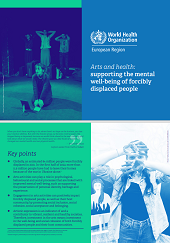Arts and health: supporting the mental well-being of forcibly displaced people
6 July 2022
| Technical document

Overview
The connection between art and mental well-being has long been recognized. Arts activities are complex or multimodal activities comprising multiple different components known to be health promoting, including social interaction, sensory activation, emotional expression, cognitive stimulation and physical activity.
The Office of the United Nations High Commissioner for Refugees estimates that in 2021 global forced displacement likely exceeded 84 million, a sharp increase from the 82.4 million reported at the end of 2020. As a result of the war in Ukraine alone, so far more than 4.8 million people are believed to have fled the country. Over 7.1 million more people remaining in the country are thought to be displaced from their homes. People who have been displaced because of natural disasters, persecution, conflict, generalized violence or human rights violations have invariably experienced significant loss, physical hardships and other stressors that can result in psychological distress. A large body of evidence shows how forcibly displaced people contribute positively to society.
This potential can be further enhanced by ensuring that these people are in good physical and mental health. The IASC Guidelines on Mental Health and Psychosocial Support in Emergency Settings outline many important ways that governments and other relevant actors can support the mental health and well-being of forcibly displaced people. Within this framework, arts activities can be one of the relevant activities to improve health and well-being by promoting multiple different psychological, behavioural and social processes. For example, arts activities can improve self-confidence, promote healthy behaviours as well as social inclusion and, importantly, offer hope.
WHO Team
Behavioural and Cultural Insights (BIF),
Country Implementation Support for Impact (CIS)
Number of pages
8




